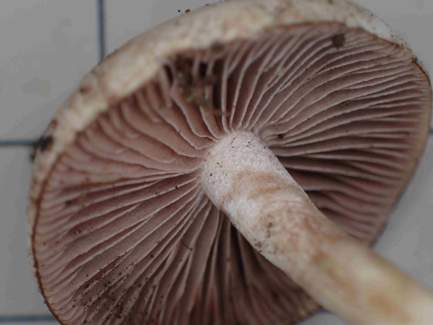 Hebeloma vinosophyllum (Photo: U. Kawasaki)
Hebeloma vinosophyllum (Photo: U. Kawasaki)Taxonomy
Full name: Hebeloma vinosophyllum Hongo, Journal of Japanese Botany 40 (10): 314 (1965)Genus: Hebeloma
Section: Porphyrospora
Types: JAPAN: Kansai, Ishizue, Otsu-city (approx. 34.9477°N, 135.9261°E, alt. approx. 125 m a.s.l.) in mixed woodland under Pinus sp. and Quercus serrata, 17 Jul. 1961, T. Hongo (Holotype. herbarium acc. no. TNS F 39101 (2294), HJB1000381; Isotype. herbarium acc. no. ZT 3309, HJB1000117).
- arrow_drop_downarrow_drop_upEtymology
- arrow_drop_downarrow_drop_upOriginal diagnosisPileo 1.5-4 cm lato, convexo, deinde convexo-expanso, obtuso, glabro, viscido, e eburneo gilvo-argillaceo, albido in zona maginali, margine primum involuta et velo fimbriata; carne medio subcrassa, in margine tenui, alba vel albida, odore obsoleto vel subfarinaceo, sapore subamaro; lamellis adnexis, profunde emarginatis, subconfertis vel subdistantibus (L=37-41; l=3-7), 2-4 mm latis, e albidis roseis, demum obscure rubro-brunneis cum tinctura vinacca, acie albo-pruinosa; stipite 2-4 cm longo, 2-6 mm crasso, deorsum incrassato, albido vel pileo pallidiore, fibrilloso, ad apicem pruinoso, e farcto solido, basi albo-tomentoso; cortina alba, fugaci; sporis in cumulo vinaceo-ferrugineis, sub microscopio ferrugineis, amygdaliformibus, punctatis-verrucosis, 10-11.5 x 7-8 μ (vel 95.-11 x 6-7 μ) ; basidiis plerumque tetrasporis, paucis bisporis, 22-27 x 7.5-9 μ; pleurocyslidiis sparsis, in parte inferiore ventricosis et in parte superiore rostratis vel filamentosis, apicem versus attenuatis, hyalinis, tenuitunicatis, 33-37 x 10-13.5 μ; cheilocystidiis numerosissimis, pleurocystidiis simillimis vel sublageniformibus, 28-44 x 8.5-21 μ; hyphis omnibus tramatis fibulatis.
- arrow_drop_downarrow_drop_upEnglish translationPileus 1.5-4 cm broad, convex, then convex-expanded, obtuse, glabrous, viscid, ivory to yellowish-argillaceous, whitish on the marginal zone, margin at first involute and fringed with veil; context slightly thick in the middle, thin at the margin, white or whitish, smell indistinct or slightly mealy, taste bitterish; lamellae adnexed, deeply emarginate, almost crowded or subdistant (L = 37-41; l = 3-7), 2-4 mm broad, whitish to pink, then a dull shade of reddish-brown tinged vinaceous, edge white, pruinose; stipe 2-4 cm long, 2-6 mm thick, enlarged downwards, whitish or paler then the pileus, fibrillose, pruinose at the apex, stuffed to firm, white-tomentose at base; cortina white, vanishing; spores vinaceous-rusty in mass, rusty under the microscope, amygdaliform, punctate-roughened, 10-11.5 x 7-8 μm (or 9.5-11 x 6-7 μ; basidia generally four-spored, few two-spored, 22-27 x 7.5-9 μ; pleurocystidia sparse, ventricose in the lower part and rostrate or filamentous in the upper part, attenuate towards the apex, hyaline, thin-walled, 33-37 x 10-13.5 μ; cheilocystidia very numerous similar to pleurocystidia or sublageniform, 28-44 x 8.5-21 μ; all hyphae of the context clamped.
References
Description
- arrow_drop_downarrow_drop_upThresholds
Description of Hebeloma vinosophyllum based on 6 collections
- arrow_drop_downarrow_drop_upMacroscopic descriptionPileus: not recorded mm diameter; shape Not recorded; characters Not recorded; margin characters Not recorded; viscosity tacky when moist; colour variation Not recorded; colour at centre Not recorded.
Lamellae: attachment Not recorded; maximum depth not recorded; number of complete lamellae 46–52; presence of tears Not recorded; white fimbriate edge often present or weak.
Cortina presence: no.
Stipe: not recorded x not recorded {median} x not recorded {basal} mm; stipe Q not recorded; base shape Not recorded; floccosity Not recorded; rooting no; thick rhizoids at base Not recorded;
Context: Texture firm; stipe interior Not recorded; stipe flesh discolouring Not recorded; slenderness measure not recorded; smell Not recorded; taste Not recorded.
Spore deposit colour: Not recorded.
Exsiccata characters: Not recorded.
- arrow_drop_downarrow_drop_upMicroscopic descriptionSpores: shape amygdaloid or limoniform; colour in microscope very pale or yellow; guttules no. papilla very strongly; Spore Code: O3 O4; (P2) P3; (D2) D3 (D4).
Basidia: (19) 20–26 x 6–9 μm; ave. Q 2.8–3.5; spore arrangement 4 spored;
Cheilocystidia: main shape lageniform or ventricose, often lanceolate, occasionally clavate, cylindrical or clavate-lageniform or clavate-ventricose; special features observed often rostrate, occasionally many collapsed in exsiccata; cheilocystidia ratios: A/M = 0.90–1.26; A/B = 0.41–0.60; B/M = 2.03–2.55.
Pleurocystidia: often seen or only close to lamella edge.
Ixocutis: epicutis thickness (measured from exsiccata) not recorded; ixocutis hyphae width not recorded; ixocutis hyphae encrustation Not recorded; shape of trama elements beneath subcutis Not recorded.
Caulocystidia: Similar to cheilocystidia but larger.
- arrow_drop_downarrow_drop_upSpore measurements
- arrow_drop_downarrow_drop_upCheilocystidia measurements
- arrow_drop_downarrow_drop_upHabitat and distributionNo associated genera are recorded for the species. The growth habit of our collections was caespitose.
According to our current collections, the species is found only in Asia-Temperate. On the continent, collections have been found only in the temperate broadleaf & mixed forests WWF biome The World Wildlife Fund (WWF) have divided the world into 867 terrestrial ecoregions. The ecoregion here is estimated by mapping from the GPS coordinates of the collection using data made available by Dinerstein et al (2017). Use this webtool to explore the ecoregions visually or see a full list of current ecoregions on Wikipedia. (Taiheiyo evergreen forests (80.0%) and Nihonkai evergreen forests (20.0%) ecoregions). From collector information, it appears collections have been found only in the 1.4 Forest – Temperate IUCN habitat We map from the collector's description of the habitat to the International Union for Conservation of Nature (IUCN)'s definition using a standardised set of rules. Please see this page for a full list of IUCN habitats.. Within Temperate Asia all our records are from Eastern Asia (Japan).
Geographic distribution
Phenology
- arrow_drop_downarrow_drop_upAdditional cited collections